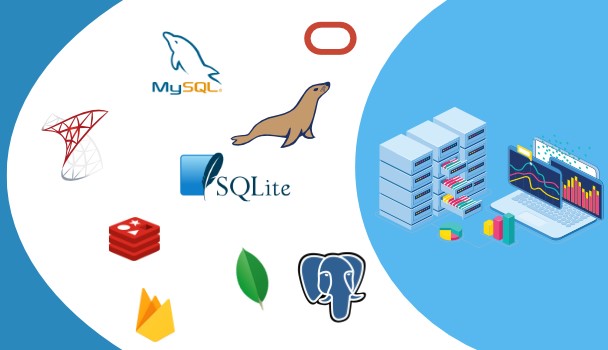A database management system (or DBMS) is simply a computerized data storage system. Users of the system are given the ability to execute a variety of actions on such a system, such as manipulating the data in the database or managing the database structure itself. Database Management Systems (DBMSs) are categorized based on their data structures or data types.
Database management systems are significant because they give a centralized view of data to programmers, database administrators, and end users, freeing applications and end users from having to understand where data is physically located. APIs (application program interfaces) manage internet requests and answers for certain sorts of data.
Types of Data Models in DBMS
A typical database management system can accommodate the following data models:
Hierarchical structure
Data is gathered in a tree-like format in a database with a hierarchical structure. This model reflects certain real-world linkages, such as cooking recipes, website sitemaps, and so on. The following are the properties of a hierarchical model:
- One-to-many relationship:- The data organization, which resembles a tree, has a one-to-many relationship between the datatype.
- Parent-child bonding:- Although a parent node might have several child nodes, each child node has a parent node.When a parent node is deleted, all child nodes are also deleted.
- Pointers:- Pointers are used to traverse between stored data and connect parent and child nodes.
The relationship model
The relational model is one of the most widely used data models. This model’s data is stored as a two-dimensional table. Data storage is organized into rows and columns. Tables are the primary building blocks of a relational model.
Tables are also referred to as relations in the relational paradigm.
The following are the major characteristics of the relational model:
- Tuples:- The rows of the table are referred to as tuples. A row contains all of the information about any object instance.
- Attribute or field:- An attribute is the property that specifies a table or relation. The values of the property should be from the same domain.
Object-oriented design
A database, according to this paradigm, is a collection of objects, or reusable software components, with linked features and operations.
There are several types of object-oriented databases, including:
- Multimedia databases- It feature images and other material kinds that cannot be stored in a relational database.
- A hypertext database- It allows any object to link to any other object.
Although it aids in the organization of large amounts of data, it is not the ideal solution for numerical analysis.
The most prevalent post-relational database paradigm, object-oriented, incorporates tables without being limited to them. These kind of systems are also known as hybrid database designs.
Amazon RDS
Amazon Relational Database Service (RDS) is an Amazon Web Services managed SQL database service (AWS).
To store and manage data, Amazon RDS offers a variety of database engines.It also aids in relational database administration chores including data transfer, backup, recovery, and patching.
Amazon RDS makes it easier to install and manage relational databases in the cloud. A cloud administrator uses Amazon RDS to set up, operate, manage and scale a relational instance of a cloud database. Amazon RDS is not itself a database; it is a service used to manage relational databases.
How does Amazon RDS function?
Databases are used to store enormous amounts of data that apps may utilize to accomplish various purposes.
Tables are used to hold data in a relational database. It is referred to be relational since it arranges data elements based on predefined connections. Amazon RDS is managed by administrators via the AWS Management Console, Amazon RDS API calls, or the AWS Command Line Interface. These APIs are used to deploy database instances to which users may apply custom configurations.
Amazon offers many instance kinds with varying resource combinations such as CPU, RAM, storage choices, and networking capabilities. Each kind is available in a range of sizes to meet the demands of various workloads.
Amazon RDS functions
Amazon RDS has the following features:
Replication:- RDS creates read duplicates using the Replication capability.
These are read-only replicas of database instances that are used by applications without affecting the underlying production database. Administrators may also use RDS Multi-AZ deployment and synchronous data replication to provide automated fail-over across different availability zones.
Storage:-RDS offers three kinds of storage:
- General-purpose solid-state drive (SSD):- Amazon recommends this storage as the default choice.
- Provisioned input-output operations per second (IOPS):- SSD storage for I/O-intensive workloads.
- Magnetic:- A lower cost option.
Monitoring:- The Amazon CloudWatch service enables managed monitoring. It lets users view capacity and I/O metrics.
Patching:- RDS provides patches for whichever database engine the user chooses.
Backups:- Another feature is failure detection and recovery. RDS provides managed instance backups with transaction logs to enable point-in-time recovery. Users pick a retention period and restore databases to any time during that period. They also can manually take snapshots of instances that remain until they are manually deleted.
Incremental billing:- Users pay a monthly fee for the instances they launch.
Encryption:- RDS uses public key encryption to secure automated backups, read replicas, data snapshots and other data stored at rest.
The Anbihian Database Management Platform offers a complete range of data solutions such as ETL, data integration, data quality, end-to-end monitoring, and security. Data Management, which is adaptable and efficient, takes the uncertainty out of the whole integration process, allowing you to extract your data when you need it to provide business insights when you need them.
